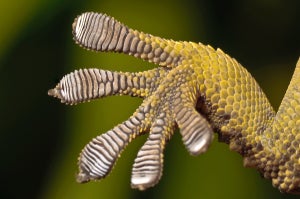LENS Engineering, Science, and Technology
Sticky Business
Creating an Adhesive for Outer Space—and Planet Earth
 IMAGE: 500PX/CARLOS GALEANO
IMAGE: 500PX/CARLOS GALEANOInspired by the super-sticky power in the hair on gecko feet, researchers have created an adhesive so unusual that it can be used in conditions as cold as outer space or hot as molten rock—environments that would cause many other binders to lose their strength.
 IMAGE: Courtesy of Ming Xu
IMAGE: Courtesy of Ming XuThe dry adhesive—shown in the rendering above—works this way: Bundled nodes of carbon nanotubes penetrate surface cavities and form web-like structures. As the surface heats, the bundles appear to penetrate deeper and further increase adhesion.
“We found this adhesive can be used over a wide temperature range, where most other adhesives, including dry adhesives, would have failed,” said Liming Dai, PhD, the Kent Hale Smith Professor in the Department of Macromolecular Science and Engineering. Dai worked with Case Western Reserve colleagues as well as researchers from China and the U.S. Air Force Research Laboratory to develop the adhesive. The team published its research last fall in Nature Communications.
The adhesive is made from bundled tube-shaped carbon material that’s about 10,000 times smaller than a human hair. Vertically aligned to create more area of contact, these carbon nanotubes—like the gecko hairs—gain tremendous adhesive strength when they bind to even a rough surface. While a gecko can hold more than 100 times its own weight, the Dai team’s adhesive provides an even stronger hold. The team also made a version that is a double-sided sticky tape.

Liming Dai, professor
And unlike most liquid and dry adhesives, which lose strength at extreme temperatures, this one actually grows stronger and stickier at high temperatures.
The potential applications are intriguing. The adhesive material could be used in outer space—where conventional versions can’t withstand the vacuum environment and extreme temperatures—to bind equipment, such as solar cells to their support structures. On Earth, it could be used in electronic equipment, such as a laptop computers and cell phones, to connect components and pull away heat generated by electrical currents.





